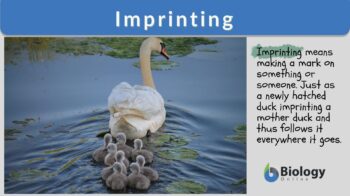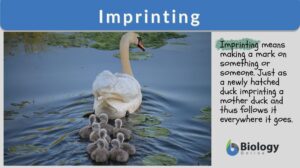
Imprinting
n., plural: imrpintings
[ˈɪm.pɹɪntɪŋ]
Definition: marking another animal (or a person or a thing)
Table of Contents
What does imprinting mean? Have you watched the TV cartoon show “Tom and Jerry” with an episode of a duck and its ducklings? One scene depicts a baby duckling being left behind after the eggs hatch. All the others followed their mother immediately and went away. Did you know why this happened? Why did all the other ducklings follow the mother? Let’s break down the science behind this…
All the other progeny were “IMPRINTED” as soon as they were born while a poor fellow was left “un-imprinted”. The episode further shows its struggle to do the basic duck-business like swimming, pecking, scratching, etc. The concept of imprinted ducks and many more such examples are explained in this article… Read on to learn more about imprinting, its definition in Biology, its purpose, and its significance in the biological world!!!


Imprinting Definition
There are many different aspects in which we can define imprinting in Biology; it may be filial, sexual, limbic, genomic, genetic, etc. According to Hess, E.H. (1959), imprinting is the early practical experience in life that determines the social imprints, attitudes, and behavior of biological organisms in their latter parts of life. What an organism sees, experiences, and undergoes in the early chapters of its life is bound to create a magnanimous effect on its behavioral psychology, life choices, and instincts later in life. This, in short, is the definition of imprinting in Psychology.
When asked what is imprinting in Biology, it can be explained as a method by which the environment interacts with heredity in some “extra-sensitive phases” of life. The input here is some stimuli, while the output is the response of that organism to that specific stimuli. This interaction is not witnessed all through life, but in a defined “critical period”.
Imprinting is the process of making an “imprint” (marking) something or someone. For example, after birth or hatching, the newborn follows another animal that it recognizes or marks as its mother (filial imprinting). Another example is when a young goose after hatching can follow its future mating partner and when mature it will start to mate with its imprinted partner (sexual imprinting).

According to Konrad Lorenz (1935), imprinting is the principle of attachment between a newly born organism and its caretaker. This concept is instinctive and explains that an animal/bird develops an attachment to the very first moving thing it encounters after birth/egg hatching. Lorenz’s subject of study was geese imprinting and he was often followed by many newly-born geese in his own estates in Austria.

Summarizing, imprinting has some characteristic features:
- Phase-specific learning (associated with a very specific life stage, age, or organism’s form)
- Has a critical period (a predetermined phase of an organism’s life when it’s highly sensitive to respond to stimuli)
- Initially thought to be irreversible in nature (still doubt persists)
Examples of Imprinting
There are several examples of birds, humans, and animals imprinting present in nature, let’s discuss them one by one.
Filial imprinting
- First reported by: Sir Thomas More (1516)
- Subject of study: Domestic chicken
- Concept: This type of imprinting is readily seen in precocial birds that are able to control their own movements after the hatching of eggs. The 2 main components are the young one and the first moving (animate or inanimate) object it encounters. This filial bond is developed between the imprinting stimulus- usually the parent and the progeny and aids in the social behavior building of the progeny. Many studies (McCabe, 2019) postulate that this type of imprinting is pre-determined since embryonic development and can also be influenced by the experience of hatching procedure by the mother.
- Observed in: Nidifugous birds, Precocial birds (ducks, geese, quails, peregrine falcon), wolf imprinting
- Importance: As this imprinting helps in social bond formation, it aids in the survival of young ones by making them learn the basics about life. It also endows the young ones with the ability to live in social structures. So, when asked: “why is imprinting important in birds?” — it’s the filial bond formation that plays a pivotal role in the behavior developmental biology of bird progeny.
Sexual imprinting

- First reported by: Probably by Bateson and Immelmann (1970s)
- Subject of study: Male Japanese quail (Coturnix coturnix japonica)
- Concept: Sexual imprinting refers to the influence in mate choices of a progeny when it looks up to its parents or conspecifics as a role model. It has been seen that both types of sexual imprinting happen in nature- positive and negative. Positive sexual imprinting is the preference of an individual to choose a future mate that resembles parents, kin, and their behavior. On the contrary, negative sexual imprinting refers to evasion of all the chances of the mate being similar to kin or its own parents. This type of imprinting strengthens the idea and identification of conspecifics.
- Observed in: Male zebra finches, giant panda, falconry birds, greylag geese
- Importance: This aids in the development of preference for conspecifics over hetero-specifics in organisms. This preference bolsters the concept of speciation and averts the possibilities of cross-breeding. The chances of adult stages of sexually-imprinted animals choosing a mate outside their species are almost nil. This phenomenon helps the organism in striking the absolutely perfect mark of preventing both outbreeding (out of species) and inbreeding (with kin); the organism chooses an individual that’s similar to kin but not kin exactly.

Limbic imprinting
- Concept: This concept deals with the “interplay and effects of all the processes related to birth” and “the long-term consequences left on the functioning of the limbic system”. In all the possible ways that our birth is affected at the 3 steps: prenatal, perinatal, and postnatal, some psychological consequence is left on the fetus or the baby (at whichever stage of development it’s present!). This concept is gathering much attention nowadays with special counseling sessions being arranged for the newly-conceived parents. This aids in acknowledging the prenatal imprinting possibilities (in utero- when baby is in the womb) and instills the consciousness among the young parents to prioritize a healthy environment for the mother. This puts a lot of difference in mother’s and future child’s psychology.
- Observed in: Animals, Human beings
- Importance: This imprinting is important because it affects the overall quality of life and psychology of an individual. What’s imprinted on a fetus via limbic imprinting almost stays with it throughout its life. As science advances, we can aim to maximize the positive limbic imprinting in humans and their young ones to provide better trauma-free lives in the future.
- Imprinting psychology example: Fetuses that suffer trauma and are limbic-imprinted meaning- affected by it often encounter troubles dealing with emotions later in their lives. The imprints made during the birth time indirectly/subconsciously drive the behavior of that adult in the future. Any physically strenuous factor or possibly harming intercession during childbirth can also leave life-long impacts on the young one’s life due to limbic imprinting.

Westermarck effect
- First reported by: Edvard Westermarck (1891)
- First reported in: Human beings
- Concept: This is just the reverse of positive sexual imprinting. It can also be called reverse sexual imprinting. According to this, individuals who live in very close proximity in the early phases or years of their lives tend to avoid each other for the latter sexual reproductive processes and marriage. The argument here is that the call for this avoidance is “innate” in individuals and not driven by cultural boundaries or taboos.
- Observed in: Most of the human settlement settings and cultures (Example: Israeli kibbutz system, Chinese Shim-pua system, etc)
- Controversies: There are several controversies hovering over this effect. For example, Jesse Bering (2010) postulates that it is very common in humans to look for similarities in their potential partner to their own parents. This is actually very common if we look around, hence the overturning of the Westermarck effect. Hence, when we define imprinting in psychology, we need to counter the arguments from both the opposing sides.

Baby duck syndrome
- Concept: It refers to the bias developed in humans for the “very first idea, system, explanation, interface” of any plan or electronic appliance, or computer. The very first system that you learn makes you too comfortable and you tend to follow/admire it unabatedly, giving no room to other possibilities and options. This makes the prospects of changes almost nil. Since learning, unlearning, and relearning are important for a conscious life, baby duck syndrome needs to be identified at its inception and be dealt with.
- Significance: This usually impedes growth and possibilities of learning new systems and technologies
- Observed in: Humans

Genetic/Genomic Imprinting
- Concept: In Genetics, the definition of imprinting goes by “the ability of a gene to bring its full-fledged expression depending on the parental sex from whom it got passed onto the progeny”. Let’s say a gene is expressed only when it’s passed on from the maternal chromosome, in that case if the progeny receives the paternal counterpart, the gene shows no expression.
- First observed by: Two labs simultaneously- “McGrath & Solter- 1984”, “Surani et al.- 1984”
- Characteristics:
No change in DNA sequence
Change in gene expression via modification in DNA (chemical structure or chromatin physical structure)
This is a type of inheritance “independent” of sequence changes. Hence it took years for scientists to decipher the concept clearly!
The sex of the parent who is contributing to the gene-carrying chromosome is of prime importance here. - Observed in: ONLY MAMMALS!
- Significance: When questioned “what is imprinting in genetics?”, we can explain that for any diploid organism, there are two copies of all alleles and even if one copy turns out to be defective from one parent, the other one compensates for it. But in genetic imprinting, even the diploid system seems like a haploid system; meaning only one of the two copies is expressed. By default, the imprinted copy is the one that’s expressed. Unlike the normal inheritance, here even if the recessive state is present but the gene is imprinted, that state is expressed at the cost of the dominant allele being silenced!!
- Diseases associated with genetic imprinting: Prader-Willi syndrome, Angelman syndrome, Beckwith-Wiedemann syndrome, Albright hereditary osteodystrophy, Silver-Russell syndrome, etc.

Interesting Fact
Genomic imprinting is observed, “only in mammals”. The mechanism by which it acts is called “epigenetics”- epi meaning “in addition to”, i.e. in addition to the basic genetic mode of inheritance. In this, the changes aren’t happening in the DNA sequence themselves; but in the nucleotide’s structure.
There is a modification of cytosine bases which are part of the CpG Islands in DNA molecules. The modification is usually methylation (addition of methyl -CH3 groups) of cytosine. It is estimated that genomic imprinting came into play nearly 150 million years ago- “the point where mammals diverged from egg-laying animals in the evolutionary timeline”!!!
Out of all the genes that all vertebrates possess, there’s a specific set that’s imprinted in mammals. This same set of genes is present in non-mammals too but it’s “unimprinted”!!
A total genomic study revealed a sum of over 150 genes that are imprinted in Homo sapiens sapiens and that is huge since these many traits are putting mother-vs-father imprinting at heads-on war with each other…
{Source: Butler M. G., 2009, Murphy S.K., Jirtle R.L. (2003), Luedi, P. P. et al (2007)}

Try to answer the quiz below to check what you have learned so far about imprinting.
References
- T. L. Brink. (2008) Psychology: A Student Friendly Approach. “Unit 12: Developmental Psychology.” pp. 268
- Harding, N. (2016). “How does animal imprinting work?”. animalanswers.co.uk.
- Hess E.H. (1959). Science- Imprinting. Current Problems in Research. 130:3368
- Burkhardt, R. W. (2005). Patterns of behaviour: Konrad Lorenz, Niko Tinbergen, and the founding of ethology. University of Chicago Press.
- Brigandt, I. (2004). The early theoretical development of Konrad Lorenz- The motivating factors behind his instinct concept.
- Lorenz, K. (1935). Der Kumpan in der Umwelt des Vogels. Der Artgenosse als auslösendes Moment sozialer Verhaltensweisen. Journal für Ornithologie, 83, 137–215, 289–413.
- McCabe B.J. (2019) Visual Imprinting in Birds: Behaviour, Models, and Neural Mechanisms. Frontiers in Physiology. https://doi.org/10.3389/fphys.2019.00658
- Lorenz, K. (1937). The companion in the bird’s world. Auk 54, 245–273. doi: 10.2307/4078077
- Irwin, D., Price, T. Sexual imprinting, learning and speciation. Heredity 82, 347–354 (1999). https://doi.org/10.1038/sj.hdy.6885270
- Hou B., Wang Y. (2018) Sexual Imprinting. In: Shackelford T., Weekes-Shackelford V. (eds) Encyclopedia of Evolutionary Psychological Science. Springer, Cham. https://doi.org/10.1007/978-3-319-16999-6_1061-1
- Bateson, P. (1978) Sexual imprinting and optimal outbreeding. Nature, 273, 659-60
- Bering J. (2010). Oedipus Complex 2.0: Like it or not, parents shape their children’s sexual preferences. Scientific American.
- Lobo, I. (2008) Genomic Imprinting and Patterns of Disease Inheritance. Nature Education 1(1):66
- McGrath, J., Solter, D. (1984) Completion of mouse embryogenesis requires both the maternal and paternal genomes. Cell 37, 179–183
- Surani, M. A. H., et al. (1984) Development of reconstituted mouse eggs suggests imprinting of the genome during gametogenesis. Nature 308, 548–550 doi:10.1038/308548a0
- Murphy S.K., Jirtle R.L. (2003) Imprinting evolution and the price of silence. Bioessays. 25(6):577-88. doi: 10.1002/bies.10277
- Butler M. G. (2009). Genomic imprinting disorders in humans: a mini-review. Journal of assisted reproduction and genetics, 26(9-10), 477–486. https://doi.org/10.1007/s10815-009-9353-3
- Luedi, P. P., Dietrich, F. S., Weidman, J. R., Bosko, J. M., Jirtle, R. L., & Hartemink, A. J. (2007). Computational and experimental identification of novel human imprinted genes. Genome research, 17(12), 1723–1730. https://doi.org/10.1101/gr.6584707
©BiologyOnline.com. Content provided and moderated by Biology Online Editors.








